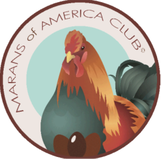Black Copper Marans
|
Here at White Mountains Ranch we are working on becoming a nationally recognized breeder of purebred Heritage Black Copper Marans. We feed them 100% Organic feed, Organic BOSS, Organic Scratch, and Organic Fruits and Veggies from our gardens. We hand raise our Marans with care and affection, and spend time with them every day.
|
A Brief History Of The Black Copper Marans
The original Marans (poule de Marans) come from the area around La Rochelle in south western France. The local chickens were known as ‘swamp chickens’ because the countryside is low and marshy.
These original landrace birds were crossed with the local barnyard hens and game cocks from India and Indonesia that were brought in by the sailors. The gamecocks were traded by them for fresh food and water and so were often plentiful in supply.
These originals came to be known as Marandaise fowl.
In later years the Marans was further refined by the addition of Croad Langshan, Brahmas, Coucou de Malines, Coucou de Rennes and Gatinaise chickens to produce the ancestors of the Maran breed we know today.
The Marans became well known locally in France for the deep red color of its eggs; the plumage however was all over the place.
In 1921 a Mrs. Rousseau started breeding with the intention of unifying the plumage and produced the cuckoo Marans – still popular today. 1930 saw the setting of the breed standard in France for this dual purpose bird. They were called Marans after the French port of the same name. By 1932 there were six recognized varieties of Marans – silver cuckoo, white/ black, black copper neck, ermine, golden cuckoo and red. Skipping forward to post war France, the breed was in a shambles and was near to non-existent. The French Department of Agriculture rescued it from obscurity and began a breeding program. One of the goals of the program was to increase egg production, which it did. By 1952 Marans were producing around 200 eggs/year.
When the program ceased, the cause of the Marans was taken up by numerous amateur enthusiasts who did a great job of keeping and improving the breed.
These original landrace birds were crossed with the local barnyard hens and game cocks from India and Indonesia that were brought in by the sailors. The gamecocks were traded by them for fresh food and water and so were often plentiful in supply.
These originals came to be known as Marandaise fowl.
In later years the Marans was further refined by the addition of Croad Langshan, Brahmas, Coucou de Malines, Coucou de Rennes and Gatinaise chickens to produce the ancestors of the Maran breed we know today.
The Marans became well known locally in France for the deep red color of its eggs; the plumage however was all over the place.
In 1921 a Mrs. Rousseau started breeding with the intention of unifying the plumage and produced the cuckoo Marans – still popular today. 1930 saw the setting of the breed standard in France for this dual purpose bird. They were called Marans after the French port of the same name. By 1932 there were six recognized varieties of Marans – silver cuckoo, white/ black, black copper neck, ermine, golden cuckoo and red. Skipping forward to post war France, the breed was in a shambles and was near to non-existent. The French Department of Agriculture rescued it from obscurity and began a breeding program. One of the goals of the program was to increase egg production, which it did. By 1952 Marans were producing around 200 eggs/year.
When the program ceased, the cause of the Marans was taken up by numerous amateur enthusiasts who did a great job of keeping and improving the breed.
Here are some of our birds...
~ All Orders On Hold ~
All Orders are currently on hold due to COVID-19.
Our hatching / shipping season runs from approximately February to September.
Please read this about our shipping eggs.
Please email us if you would like more information: whitemountainsranch@gmail.com


